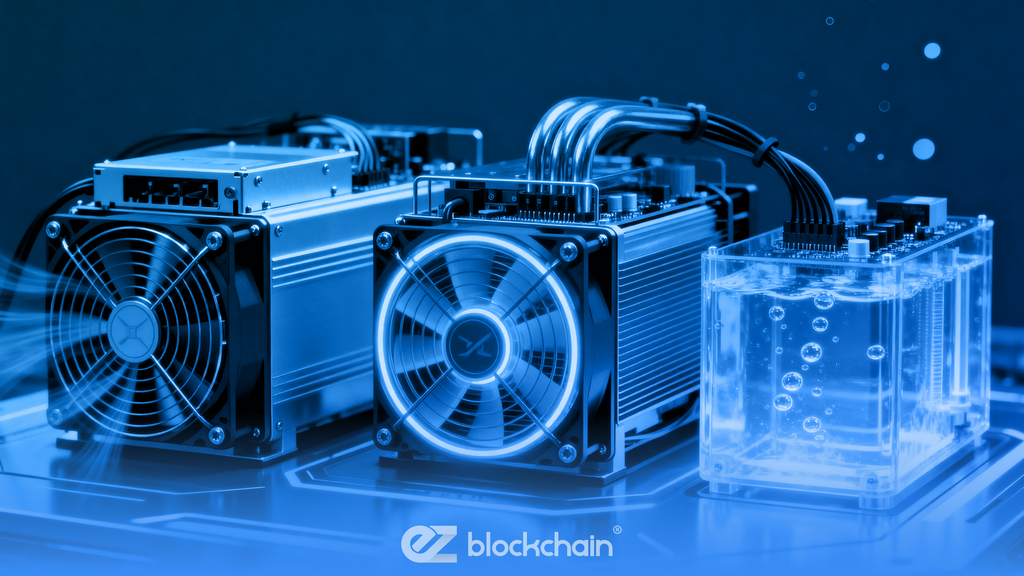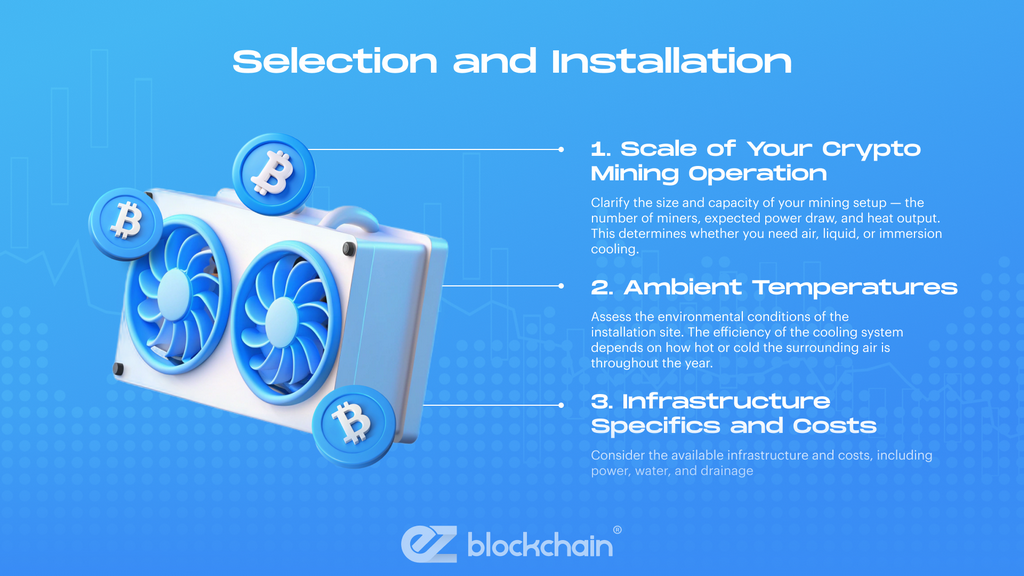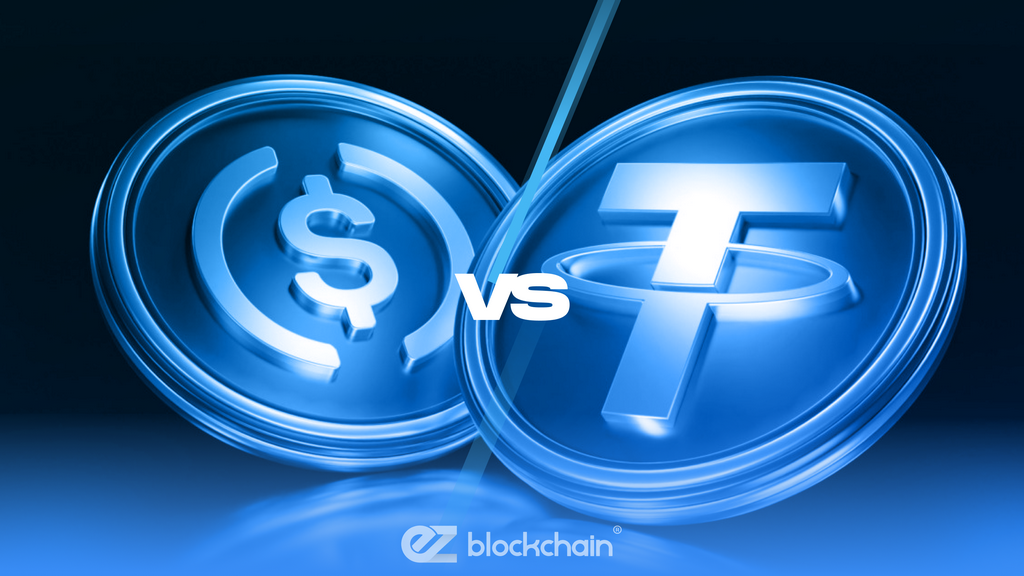Stay up to date with the latest news, announcements, and articles.
ASICs are also great in that they are easy to maintain. Due to high hash rates generated by the ASICs, they generate tons of heat, which is the main wear factor influencing the miner’s lifespan. However, if you know your cooling system and watch its condition, you can avoid any persisting heat issues and negative effects altogether.
To figure it out and really keep your cooling in check, let’s take a look at the main types of crypto mining cooling solutions, their main characteristics and nuances, and help you choose one.

Types of Cooling Systems
As much as heating and cooling is critical in ASICs, these devices have become dominant solo rigs exactly due to the minimum of maintenance required. Most commonly, a good ASIC miner comes with a well-optimized cooling system right from the factory. The most you need to do is keep it clean from dust clogs and monitor its RPM readings from time to time.
But you may want to figure out the cooling specifics of your rig more in-depth in two cases:
- A perfectly fitting and performing cooling kit out-of-the-box isn’t always the case, which is when you may need to switch the type of system installed.
- You want to squeeze out the max potential out of your rig, keep it as safe as possible and prolong its lifespan, and implement other “advanced user” tasks for an ASIC.
“Cooling affects ASIC lifespan strongly. High and fluctuating temperatures degrade chips, memory, and power regulation boards.”
Knowing your ASIC miner cooling kits not only allows you to replace faulty coolers and pick better component options. By upgrading the cooling, you can also find ways to balance out the miner’s heating and boost its overall performance, potentially by loads of hashrate.
But before you indulge in all of that, let’s first go through the main types of cooling in ASIC miners.
Air cooling systems
The most baseline traditional system that comes with 80% of ASICs sold on today’s market. A usual air cooling setup consists of:
- Built-in fans
- Ambient airflow
- External ventilation or AC units (optionally)
It’s simple, affordable, and tested by years of global exploitation. Such systems can be more reliable and performing in good airflow conditions, with an optimal level of humidity, and in colder climates.
However, the downsides are:
- Constant dust accumulation
- Noise from the fans
- High power consumption
Keeping those fans spinning at all times is quite energy-demanding, which limits the total efficiency of air cooling in comparison with some other existing solutions. Nevertheless, this traditional way of cooling works great for smaller-scale setups. With larger farms, there may be struggles with heat spots, high power usage effectiveness (PUE), and component wear.
Immersion cooling overview
Immersion cooling, aka ASIC oil cooling, is when the miner is submerged in a dielectric liquid — mineral oil or specially engineered fluid. A specialized ASIC miner cooling box is used to enable uniform heat removal, as there is simply no room for heat to accumulate in the liquid, it can only disperse.
This approach stands out with near-silent operation and fewer shocks from thermal cycling. Such a system also provides for a higher miner overclocking potential. After all, it handles heat loads more efficiently than air, allowing for significant power cost savings and hardware lifespan boosts.
Hydro cooling options
Another type of ASIC liquid cooling is a more familiar hydro system that uses water (or a similar prepared liquid) to battle heat accumulation. Hydro cooling blends principles of water conduction with direct cooling. For this, water blocks or special radiator loops are commonly used.
Real-world examples include water cooled Bitcoin miner units that route cooled liquid to hotspots via custom vents, like the Bitdeer SealMiner A2 Pro Hyd. Ultimately, watercooled ASIC miner models dissipate heat very efficiently.
On the flip side, however, hydro setups require plumbing, coolant refreshing, pumps change, leak protection, and sometimes chillers. While certainly granting better cooling than air and less complexity than full immersion, hydro cooling will also require more maintenance and potentially higher infrastructure costs.

Financial and Technical Considerations
To help you weigh out and pick the best option for long-lasting ASIC miner’s operation,
Cost comparison
First off, of course, how much are you ready to invest in your ASIC’s cooling effectiveness? Depending on your budget capabilities and ambitions, you can either save some upfront costs (and get potentially smaller paybacks, but sooner) or invest more in upgraded cooling (and get potentially higher ROI, but overtime).
- Air cooling is affordable upfront — all it has is fans, casing space, and basic ventilation. But operating costs, including electricity and HVAC, can grow pretty high, especially when running an ASIC rig in hotter climates.
- Immersion and ASIC hydro cooling systems require a much higher initial capital expenditure, due to all the built-in tanks and pumps, replenishable liquid and coolants, and containment maintenance. But they often reduce ongoing cooling & energy costs by 20-50%. Over time, ROI improves for large operations or in locations with high electricity costs.
- As a possible alternative, DIY kits (e.g., custom miner cooling kits, individually connected hydro cooling, and variously shaped boxes) can help you lower the cost barrier somewhat, but make sure to watch for quality and safety guarantees.
More affordable solutions allow you to start up operations promptly, without focusing too much on technicalities, and start earning crypto. Alternatively, cooling systems that are pricier upfront and may call for extra care will bring bigger pay backs, but only overtime.
The final choice depends on your priorities — fast start for immediate grabs or planned, continuous operation for total profits. But it can also be influenced by the following considerations as to how much you will need to maintain different cooling systems and what impacts their lifespans.
Maintenance needs
Each described type cooling requires different extents of maintenance:
- Air cooling requires:
- Frequent filter and fan maintenance
- Dust cleaning
- Fans’ replacement
- Management of the airflow and heat spots
- With hydro cooling, you will need to:
- Occasionally check for leaks, coolant degradation, and pump wear
- Maintain the radiator or water block
- Replace fluid
- You might also need to protect a liquid cooling ASIC miner from freeze and corrosion
- For stable immersion or mineral oil cooling for an ASIC, you will need to:
- Watch the purity of fluid you use (this keeps dielectric fluid properties stable)
- Replace liquid regularly
- Watch for overflow or spillage
- Manage the cooling loop and heat exchangers
- Watch for possible compatibility issues with fluid.
Performance and lifespan impacts
- Cooling affects ASIC lifespan strongly. High and fluctuating temperatures degrade chips, memory, and power regulation boards. Stable cooling (especially immersion or hydro) reduces thermal stress and extends hardware life by perhaps 1.5-2× compared to harsh air-cooled setups.
- Higher performance: cooling solutions like immersion or hydro let miners safely overclock, sustaining higher hash rates without throttling. For example, miners using immersion report 20-40% performance boost.
Selection and Installation
When choosing a cooling system, clarify these questions:
- What is the scale of your crypto mining operation?
- What are the ambient temperatures in the space where miners will be installed?
- What are your infrastructure specifics and costs, including power, water, and drainage?
For small to mid rigs, air or retrofit hydro kits may suffice. For a bigger farm setup, immersion or advanced liquid systems will make a more optimal solution. But whatever the pick you will make, make sure to maintain cooling as priority to the best of your ability, for prolonged ASIC service with high ROI.

Efficiency vs Cost
Cooling efficiency is about how much heat you remove per watt of cooling power. So the more the cooling system can handle, the more electricity expenses you are looking to save.
- Immersion or mineral oil cooling tends to grant the top ratio due to minimal fan or HVAC overhead.
- Hydro cooling sits in the middle — better than air but still needs pumps, radiators, and flow control.
- Air is lowest in efficiency for high load and warm ambient. But the cost tradeoff depends on electricity price, fluid cost, infrastructure expenses, and mining scale.
Need to pick the best cooling solution for ASIC crypto mining? Experts at EZ Blockchain will help select the best available rig for your needs, host it, and scale it cost-efficiently. Contact us to consult before you make an investment.
Fill out a form and our bitcoin mining expert will contact you.
FREE CONSULTATIONchoose
a miner
profit and
understand data?
business remotely
with EZ Blockchain?
Fill out a form and our bitcoin mining expert will contact you.









